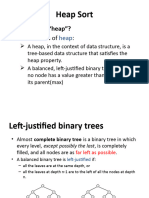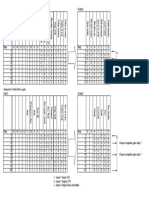0% found this document useful (0 votes)
32 views10 pagesDutton Weak Heaps
The document presents a new data structure called a weak-heap, which relaxes the traditional heap requirements and can be implemented with one extra bit per data item. The weak-heap sorting algorithm, WeakHeapSort, is introduced, showing competitive performance with a worst-case comparison count less than (n - 1)log n + 0.086013n. The paper includes theoretical analysis and empirical results, demonstrating the efficiency of weak-heaps in sorting compared to traditional heapsort algorithms.
Uploaded by
MJCopyright
© © All Rights Reserved
We take content rights seriously. If you suspect this is your content, claim it here.
Available Formats
Download as PDF, TXT or read online on Scribd
0% found this document useful (0 votes)
32 views10 pagesDutton Weak Heaps
The document presents a new data structure called a weak-heap, which relaxes the traditional heap requirements and can be implemented with one extra bit per data item. The weak-heap sorting algorithm, WeakHeapSort, is introduced, showing competitive performance with a worst-case comparison count less than (n - 1)log n + 0.086013n. The paper includes theoretical analysis and empirical results, demonstrating the efficiency of weak-heaps in sorting compared to traditional heapsort algorithms.
Uploaded by
MJCopyright
© © All Rights Reserved
We take content rights seriously. If you suspect this is your content, claim it here.
Available Formats
Download as PDF, TXT or read online on Scribd
/ 10






















































































